This is science?
By Kara Gadeken, College of William & Mary undergraduate student
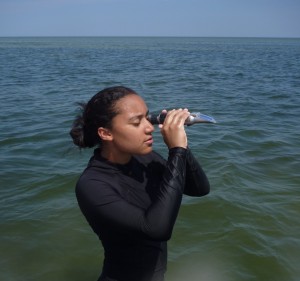
Undergraduate student Kara Gadeken takes water salinity measurements at Goodwin Islands, Virginia USA
Interning at VIMS during the hectic months when the ZEN project was at its peak was an experience that I will never forget.
The main reason that I wanted to take part in it was that, as an impassioned yet inexperienced college student, I had a reasonable knowledge base in biology but had no idea what it was like to actually do research, much less to be a part of such a grand-scale project as the ZEN. I approached Dr. Duffy at the suggestion of one of my professors at William and Mary, and luckily enough at this point his lab could use all of the help I could give.
I think the first thing that I realized while working in the Marine Biodiversity lab was that an insane amount of planning and preparation goes into research. Pamela had sticky notes and checklists and reminders all over everything in the lab, and two weeks of putting supplies together could count on one efficient day in the field. I also discovered that biologists, and especially experimental ecologists, almost have to have some engineering blood in them. In my first week at VIMS I sat in on a lab meeting to figure out how to design and construct cages to exclude predatory fish and crabs out in the seagrass beds. Time after time I heard, “How about this random thing? Hmm, I’m not sure that’ll work…How about this other random thing? Yeah, we can make something out of that!” Someone would hold up a piece of bent wire, some cable ties, bits of rope and mesh, some plastic plates. They hurled out idea after idea, trying to come up with something that could be constructed into a cage-like apparatus that would anchor into the sediment and withstand the waves. I remember stitching mesh together on an industrial sewing machine thinking, “This is science?” It didn’t take me long to realize that experiments are complicated. Not everything is perfect, and sometimes you have to work with what you’ve got, or make something new. Continue Reading
Undergraduate Education
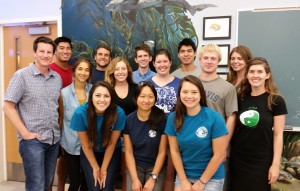 A novel component of the second generation of ZEN includes a formal integration of undergraduate education and involvement in the ZEN program. In spring 2014, we launched a coordinated upper division undergraduate Seagrass Ecosystem Ecology course at each of the three core ZEN sites: College of William & Mary, San Diego State University, and the University of California, Davis. The course focused on ecological theory and hands on training in marine ecology.
A novel component of the second generation of ZEN includes a formal integration of undergraduate education and involvement in the ZEN program. In spring 2014, we launched a coordinated upper division undergraduate Seagrass Ecosystem Ecology course at each of the three core ZEN sites: College of William & Mary, San Diego State University, and the University of California, Davis. The course focused on ecological theory and hands on training in marine ecology.
Research Network
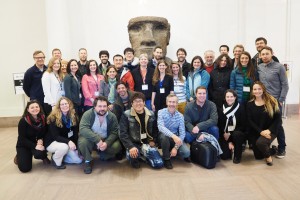 ZEN includes partners from seven US states and sixteen countries — Japan, South Korea, Canada, USA, Mexico, Norway, Sweden, Finland, Croatia, Ukraine, the Netherlands, Russia, France, Ireland, Wales, and Portugal. Partners include professors, postdoctoral researchers, graduate students, undergrads, and scientific staff. Our group’s expertise encompasses experimental ecology, population genetics, taxonomy, systematics, and quantitative analytical methods.
ZEN includes partners from seven US states and sixteen countries — Japan, South Korea, Canada, USA, Mexico, Norway, Sweden, Finland, Croatia, Ukraine, the Netherlands, Russia, France, Ireland, Wales, and Portugal. Partners include professors, postdoctoral researchers, graduate students, undergrads, and scientific staff. Our group’s expertise encompasses experimental ecology, population genetics, taxonomy, systematics, and quantitative analytical methods.
New paper in Ecology Letters!
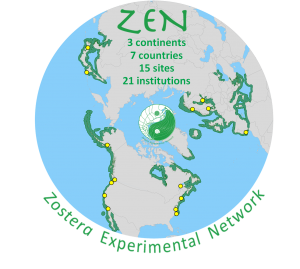 ZEN The first paper from our cross-cite experiment program is now published online at Ecology Letters! Our results link global and local evidence that biodiversity and top–down control strongly influence functioning of threatened seagrass ecosystems, and suggest that biodiversity is comparably important to global change stressors. See the press release and photos on our blog.
ZEN The first paper from our cross-cite experiment program is now published online at Ecology Letters! Our results link global and local evidence that biodiversity and top–down control strongly influence functioning of threatened seagrass ecosystems, and suggest that biodiversity is comparably important to global change stressors. See the press release and photos on our blog.
Why Seagrass?
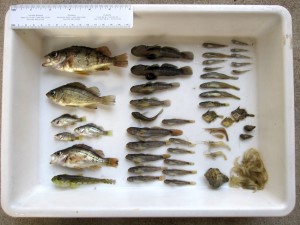 Seagrass beds are highly productive habitats, and provide structure and food for dense and diverse communities of animals. Seagrasses stabilize sediment, buffer coastlines, and improve water clarity, nutrient cycling and production. In many areas of the world eelgrass and other seagrasses serve as nursery habitats for juvenile fishes and shellfish, thus providing essential habitat for fisheries.
Seagrass beds are highly productive habitats, and provide structure and food for dense and diverse communities of animals. Seagrasses stabilize sediment, buffer coastlines, and improve water clarity, nutrient cycling and production. In many areas of the world eelgrass and other seagrasses serve as nursery habitats for juvenile fishes and shellfish, thus providing essential habitat for fisheries.

